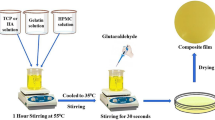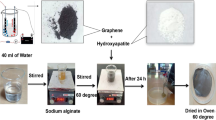Abstract
Standard and hybrid polymer nanocomposites based on poly(ɛ-caprolactone) (PCL), hydroxyapatite (HAp) and graphene oxide (GO). The GO synthetized here is made up of multilayer graphene oxide (mGO), in which up to five layers are stacked and lateral size around of 1 µm. The nanocomposites (PCL/Hap, PCL/mGO and PCL/HAp/mGO) were prepared by melt mixing in a twin-screw extruder and characterized by mechanical test, transmission electron microscopy (TEM), infrared spectroscopy (FTIR), X-ray diffraction (XRD), contact angle (CA), surface zeta potential by streaming and cell proliferation. The HAp content was maintained at 20% (w/w) while mGO was used at three levels of content (0.05, 0.1, and 0.3 w/w). In terms of bulk properties, the presence of mGO even in very low content (0.05 to 0.3%) was very effective in order to increase mechanical properties of PCL (stress and strain at beak and tenacity) while HAp tends to decrease them. When the two fillers are inserted mGO act to recover the properties lost by the presence of HAp. TEM images showed single GO sheets very well dispersed alone or combined with HAp. For surface properties, significant changes have been achieved by the presence of mGO, HAp and mGO/HAp. The water contact angle drops to values below 90° for all nanocomposites making the material hydrophilic, but again by the presence of only 0.05% of mGO it was reached easily. Surface ξ-potential for all nanocomposite was lower than neat PCL. As a consequence of surface modifications improvements in cell proliferation ability could be also observed. All modification by the presence of GO point out these materials as excellent candidates to resorbable suture, drug delivery system, and bone graft substitutes.









Similar content being viewed by others
References
Guo B, Ma PX (2014) Synthetic biodegradable functional polymers for tissue engineering: a brief review. Sci China Chem 57:490–500. https://doi.org/10.1007/s11426-014-5086-y
Ulery BD, Nair LS, Laurencin CT (2011) Biomedical applications of biodegradable polymers. J Polym Sci B 49:832–864. https://doi.org/10.1002/polb.22259
Williams JM, Adewunmi A, Schek RM, Flanagan CL, Krebsbach PH, Feinberg SE, Hollister SJ, Das S (2005) Bone tissue engineering using polycaprolactone scaffolds fabricated via selective laser sintering. Biomaterials 26:4817–4827. https://doi.org/10.1016/j.biomaterials.2004.11.057
Chuenjitkuntaworn B, Inrung W, Damrongsri D, Mekaapiruk K, Supaphol P, Pavasant P (2010) Polycaprolactone/hydroxyapatite composite scaffolds: preparation, characterization, and in vitro and in vivo biological responses of human primary bone cells. J Biomed Mater Res A 94:241–251. https://doi.org/10.1002/jbm.a.32657
Shor L, Güçeri S, Wen X, Gandhi M, Sun W (2007) Fabrication of three-dimensional polycaprolactone/hydroxyapatite tissue scaffolds and osteoblast-scaffold interactions in vitro. Biomaterials 28:5291–5297. https://doi.org/10.1016/j.biomaterials.2007.08.018
Place ES, George JH, Williams CK, Stevens MM (2009) Synthetic polymer scaffolds for tissue engineering. Chem Soc Rev 38:1139–1151. https://doi.org/10.1039/b811392k
Li X, Zhang Q, Ye D, Zhang J, Guo Y, You R, Yan S, Li M, Qu J (2016) Fabrication and characterization of electrospun PCL/antheraea pernyi silk fibroin nanofibrous scaffolds. Polym Eng Sci 57:206–213. https://doi.org/10.1002/pen
Cheang P, Khor KA (2003) Effects of particulate morphology on the tensile behaviour of polymer-hydroxyapatite composites. Mater Sci Eng A 345:47–54. https://doi.org/10.1016/S0921-5093(02)00284-8
Yang H, Li F, Shan C, Han D, Zhang Q, Niu L, Ivaska A (2009) Covalent functionalization of chemically converted graphene sheets via silane and its reinforcement. J Mater Chem 19:4632. https://doi.org/10.1039/b901421g
Ramanathan T, Abdala AA, Stankovich S, Dikin DA, Herrera-Alonso M, Piner RD, Adamson DH, Schniepp HC, Chen X, Ruoff RS, Nguyen ST, Aksay IA, PrudHomme RK, Brinson LC (2008) Functionalized graphene sheets for polymer nanocomposites. Nat Nanotechnol 3:327–331. https://doi.org/10.1038/nnano.2008.96
Novoselov KS, Geim AK, Morozov SV, Jiang D, Zhang Y, Dubonos SV, Grigorieva IV, Firsov AA (2004) Electric field effect in atomically thin carbon films. Science 306:666–669. https://doi.org/10.1126/science.1102896
Miró P, Audiffred M, Heine T (2014) An atlas of two-dimensional materials. Chem Soc Rev 43:6537. https://doi.org/10.1039/C4CS00102H
Zhao H, Ding R, Zhao X, Li Y, Qu L, Pei H, Yildirimer L, Wu Z, Zhang W (2017) Graphene-based nanomaterials for drug and/or gene delivery, bioimaging, and tissue engineering. Drug Discov Today 22:1302–1317. https://doi.org/10.1016/j.drudis.2017.04.002
Paszkiewicz S, Szymczyk A, Livanov K, Wagner HD, Rosłaniec Z (2015) Enhanced thermal and mechanical properties of poly(Trimethylene terephthalate-block-poly(tetramethylene oxide) segmented copolymer based hybrid nanocomposites prepared by in situ polymerization via synergy effect between SWCNTs and graphene nanoplatelets. Express Polym Lett 9:509–524. https://doi.org/10.3144/expresspolymlett.2015.49
Ribeiro H, Trigueiro JPC, Lopes MC, Pedrotti JJ, Woellner CF, Silva WM, Silva GG, Ajayan PM (2018) Enhanced thermal conductivity and mechanical properties of hybrid MoS2/h-BN polyurethane nanocomposites. J Appl Polym Sci. https://doi.org/10.1002/app.46560
Li J, Wong PS, Kim JK (2008) Hybrid nanocomposites containing carbon nanotubes and graphite nanoplatelets. Mater Sci Eng A 483–484:660–663. https://doi.org/10.1016/j.msea.2006.08.145
Muñoz PAR, de Oliveira CFP, Amurin LG, Rodriguez CLC, Nagaoka DA, Tavares MIB, Domingues SH, Andrade RJE, Fechine GJM (2018) Novel improvement in processing of polymer nanocomposite based on 2D materials as fillers. Express Polym Lett 12:930–945. https://doi.org/10.3144/expresspolymlett.2018.79
Hansen FK (2004) Surface energy of polymers, pp. 1–12.
Shen J, Shi M, Li N, Yan B, Ma H, Hu Y, Ye M (2010) Facile synthesis and application of Ag-chemically converted graphene nanocomposite. Nano Res 3:339–349. https://doi.org/10.1007/s12274-010-1037-x
Vanquickenborne LG, Vranckx J, Görller-walrand C (1974) Kinetic trans effect in square planar transition metal complexes. J Am Chem Soc 96:4121–4125. https://doi.org/10.1016/j.carbon.2007.02.034
Zhang J, Yang H, Shen G, Cheng P, Zhang J, Guo S (2010) Reduction of graphene oxide vial-ascorbic acid. Chem Commun 46:1112–1114. https://doi.org/10.1039/b917705a
Gokalp N, Ulker C, Guvenilir YA (2016) Synthesis of polycaprolactone via ring opening polymerization catalyzed by Candida antarctica lipase B immobilized onto an amorphous silica support. J Polym Mater 33:87–100
Gasga J, Martínez-Piñeiro EL, Álvarez G, -Orozco GE, García-García R, Brès EF (2013) XRD and FTIR crystallinity indices in sound human tooth enamel and synthetic hydroxyapatite. Mater Sci Eng C 33:4568–4574. https://doi.org/10.1016/j.msec.2013.07.014
Venkateswarlu K, ChandraBose A, Rameshbabu N (2010) X-ray peak broadening studies of nanocrystalline hydroxyapatite by WilliamsonHall analysis. Phys B 405:4256–4261. https://doi.org/10.1016/j.physb.2010.07.020
Carmona VB, De Campos A, Marconcini JM, Mattoso LHC (2014) Kinetics of thermal degradation applied to biocomposites with TPS, PCL and sisal fibers by non-isothermal procedures. J Therm Anal Calorim 115:153–160. https://doi.org/10.1007/s10973-013-3259-0
Ren X, Tu Z, Wang J, Jiang T, Yang Y, Shi D, Mai YW, Shi H, Luan S, Hu GH (2017) Critical rubber layer thickness of core-shell particles with a rigid core and a soft shell for toughening of epoxy resins without loss of elastic modulus and strength. Compos Sci Technol 153:253–260. https://doi.org/10.1016/j.compscitech.2017.10.027
de Oliveira CFP, Muñoz PA, dos Santos MC, Medeiros GS, Simionato A, Nagaoka DA, de Souza EAT, Domingues SH, Fechine GJM (2019) Tuning of surface properties of poly(vinyl alcohol)/graphene oxide nanocomposites. Polym Compos 40:E312–E320. https://doi.org/10.1002/pc.24659
Kai W, Hirota Y, Hua L, Inoue Y (2008) Thermal and Mechanical Properties of a Poly(caprolactone)/Graphite Oxide Composite. J. Appl. Polym. Sci. 107:1395–1400
Wan C, Chen B (2011) Poly(ε-caprolactone)/graphene oxide biocomposites: mechanical properties and bioactivity. Mater Biomed. https://doi.org/10.1088/1748-6041/6/5/055010
Zhou K, Gao R, Jiang S (2017) Morphology, thermal and mechanical properties of poly (ε-caprolactone) biocomposites reinforced with nano-hydroxyapatite decorated graphene. J. Colloid Interface Sci. 496:334–342. https://doi.org/10.1016/j.jcis.2017.02.038
De Queiroz AAA, Franca EJ, Abraham GA, Román JS (2002) Ring-opening polymerization of ε-caprolactone by iodine charge-transfer complex. J Polym Sci B 40:714–722. https://doi.org/10.1002/polb.10133
Grenho L, Manso MC, Monteiro FJ, Ferraz MP (2012) Adhesion of Staphylococcus aureus, Staphylococcus epidermidis, and Pseudomonas aeruginosa onto nanohydroxyapatite as a bone regeneration material. J Biomed Mater Res A 100:1823–1830. https://doi.org/10.1002/jbm.a.34139
Chen J, Zhang Y, Zhang M, Yao B, Li Y, Huang L, Li C, Shi G (2016) Water-enhanced oxidation of graphite to graphene oxide with controlled species of oxygenated groups. Chem Sci 7:1874–1881. https://doi.org/10.1039/c5sc03828f
Oliveira CFP, Munoz PAR, dos Santos MCC, Medeiros GS, Simionato A, Nagaoka DA, de Souza EAT, Domingues SH, Fechine GJM (2019) Tuning of surface properties of poly(vinyl alcohol)/graphene oxide nanocomposites. Polym Compos 40:E312–E320. https://doi.org/10.1002/pc24659
Rosa V, Xie H, Dubey N, Madanagopal TT, Rajan SS, Morin JLP, Islam I, CastroNeto AH (2016) Graphene oxide-based substrate: physical and surface characterization, cytocompatibility and differentiation potential of dental pulp stem cells. Dent Mater. https://doi.org/10.1016/j.dental.2016.05.008
Dreyer DR, Todd AD, Bielawski CW (2014) Harnessing the chemistry of graphene oxide. Chem Soc Rev 43:5288–5301. https://doi.org/10.1039/c4cs00060a
Acknowledgements
The authors acknowledge funding from Fundação de Amparo à Pesquisa do Estado de São Paulo (FAPESP), Grants 2014/22840–3 and 2012/50259–8. This work was also partially funded by Fundo Mackenzie de Pesquisa (MackPesquisa). P.A.R.M. is supported by a fellowship from FAPESP, 2015/16591–3. This study was also supported in part by the Coordenação de Aperfeiçoamento de Pessoal de Nível Superior—Brasil (CAPES)—PRINT 88887.310339/2018–00. V.R. was supported by the grants from the National University Hospital System, Singapore (NUHS Open Collaborative Research Grant NUHS O-CRG 2016 Oct-25). The authors also gratefully acknowledge the National Institute (INCT) for Complex Functional Materials (INOMAT) and Nanocarbon (INCT-Carbon) for the use of the TEM and other facilities.
Author information
Authors and Affiliations
Corresponding author
Additional information
Publisher's Note
Springer Nature remains neutral with regard to jurisdictional claims in published maps and institutional affiliations.
Rights and permissions
About this article
Cite this article
Medeiros, G.S., Muñoz, P.A.R., de Oliveira, C.F.P. et al. Polymer Nanocomposites Based on Poly(ε-caprolactone), Hydroxyapatite and Graphene Oxide. J Polym Environ 28, 331–342 (2020). https://doi.org/10.1007/s10924-019-01613-w
Published:
Issue Date:
DOI: https://doi.org/10.1007/s10924-019-01613-w




